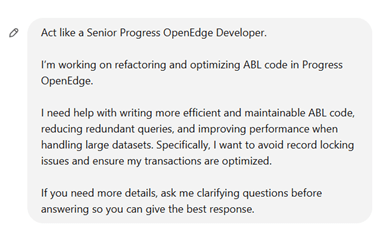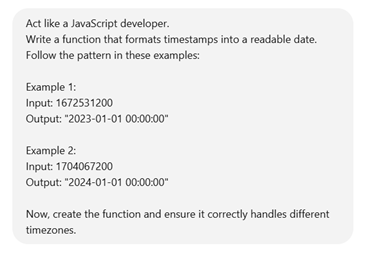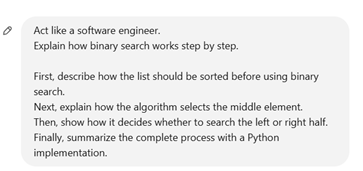AI is a powerful tool, but its accuracy depends on how you communicate with it. If the response isn’t what you expected, the problem might not be the AI—it might be how you asked the question.
Do you know how to frame your questions effectively? The difference between a vague answer and a precise, useful response comes down to understanding how to speak AI’s language.
1. The Blueprint: Crafting a Strong AI Prompt
1.1 Prompt Example
1.2 Explanation of Each Element
- Act Like a [Role/Expert]
- I’m Working On [Project/Technology]
- I Need Help With [Specific Problem or Goal]
- Ask Clarifying Questions Before Answering
2. Refining Your AI Prompts for Better Responses
2.1 One-Shot Prompting – Direct & Precise Instructions
2.2 Few-Shot Prompting – Provide Examples to Guide AI
2.3 Chain-of-Thought Prompting – Improve AI’s Reasoning
2.4 Least-to-Most Prompting – Encourage AI to Identify Subproblems
1. The Blueprint: Crafting a Strong AI Prompt
A well-structured prompt ensures AI understands the task clearly, reducing errors and improving problem-solving. Here’s a powerful template to follow:
1.1 Prompt example template:
“Act like a [role/expert].
I’m working on [project/technology].
I need help with [specific problem or goal].
If you need more details, ask clarifying questions before answering such that you will give the best response. “
1.2 Explanation of Each Element
Act Like a [Role/Expert]
Why? AI generates more relevant responses when it understands from whose perspective it should respond. Without a specified role, AI might provide generic answers instead of expert-level insights. Assigning a role ensures the response aligns with the expertise needed.
Example: “Act like a Progress OpenEdge expert. Review this ABL procedure and suggest best practices for performance and maintainability. Ensure it follows indexing best practices and avoids unnecessary record fetching. “
I’m Working On [Project/Technology]
Why? Providing context about your project helps AI tailor the response to your specific use case. Without clear context, AI might generate a generic solution that doesn’t fully align with your tech stack, architecture, or development needs.
Examples: “ I’m working on an Angular frontend that consumes data from a backend API. I need help optimizing API calls and managing state efficiently to reduce unnecessary re-renders.”
I Need Help With [Specific Problem or Goal]
Why? The more specific your problem, the better the response. AI works best with clear and detailed questions rather than vague requests like “I need help with OpenEdge.” Providing specific details helps AI focus on the actual issue instead of generating generic answers.
Examples: “I need help optimizing a complex database query in OpenEdge to improve performance on large datasets.“
Ask Clarifying Questions Before Answering
Why? Sometimes, AI needs more details to provide the best answer. Encouraging AI to ask clarifying questions first helps refine the response, ensuring it aligns with your exact needs rather than making assumptions. This approach ensures AI doesn’t assume missing details but instead clarifies the requirements before generating a solution.
Example With This approach: ” Before answering, ask me any questions that would help you provide the most accurate and relevant response.”
2. Refining Your AI Prompts for Better Responses
So far, we’ve covered how structuring your prompts with role-based instructions, context, and specific problem statements helps AI generate better responses. However, to truly maximize the effectiveness of AI, you can apply advanced prompting techniques that refine the way AI interprets and answers your requests.
In this section, we’ll dive deeper into four essential techniques that take AI prompting to the next level:
2.1 One-Shot Prompting – Direct & Precise Instructions
Use when: You need a direct, precise answer without examples.
Example Before Refinement (Basic Prompt)
Act like a Python expert.
I need help writing a function that parses JSON.
Example After Refinement (One-Shot Applied)
Why it works? The refined prompt provides clear expectations, making the AI’s response more useful.
2.2 Few-Shot Prompting – Provide Examples to Guide AI
Use when: You need AI to follow a specific format or pattern in its response.
Example Before Refinement (Basic Prompt)
Act like a JavaScript developer.
Write a function that formats timestamps.
Example After Refinement (Few-Shot Applied)
Why it works? The AI follows the provided pattern, ensuring a more consistent and accurate response.
2.3 Chain-of-Thought Prompting – Improve AI’s Reasoning
Use when: The problem is complex, and AI should break it down step by step.
Example Before Refinement (Basic Prompt)
Act like a software engineer.
Explain how binary search works.
Example After Refinement (Chain-of-Thought Applied)
Why it works? AI will walk through each step, ensuring clarity and reducing mistakes.
2.4 Least-to-Most Prompting – Encourage AI to Identify Subproblems
Use when: The problem is too large, and AI should break it down into smaller parts before solving it.
Example Before Refinement (Basic Prompt)
Act like a cloud engineer.
How can I set up a scalable microservices architecture in AWS?
Example After Refinement (Least-to-Most Applied)
Why it works? AI starts by defining key subproblems, ensuring nothing is overlooked before jumping to a solution.
Mastering AI prompting transforms vague queries into precise, actionable responses. By defining the role, context, and problem clearly you maximize AI’s potential and ensure more accurate, useful solutions.
Author: Oriana Trif, Junior Developer
She is a vibrant junior OpenEdge developer known for her energy, positivity, and constant smile. She uplifts everyone around her, turning challenges into opportunities with her joyful and encouraging spirit.








